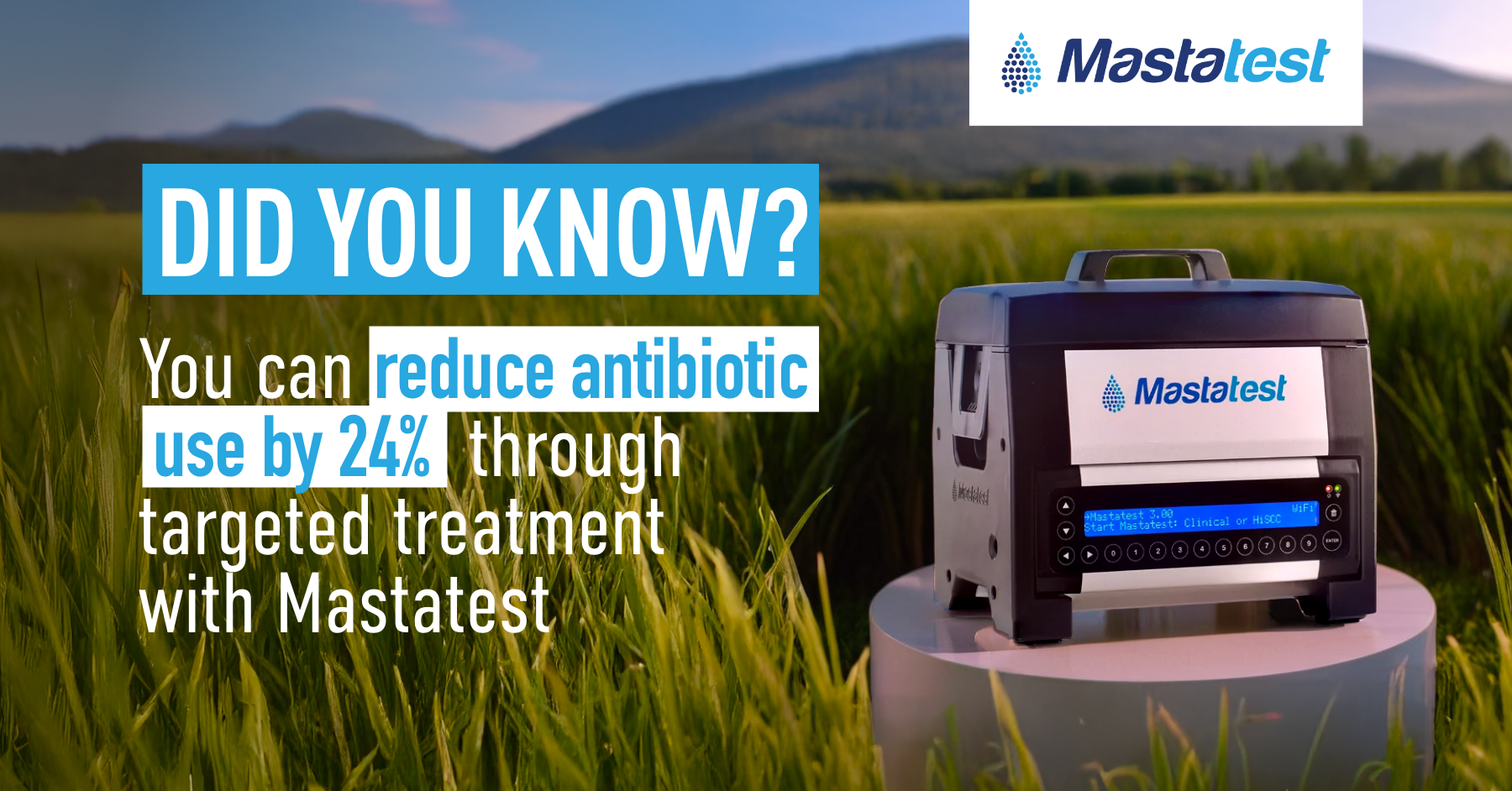Economic Impact of Mastitis in Dairy Cows
Mastitis is one of the costliest diseases in the dairy sector, causing significant economic losses in the global dairy industry by primarily affecting milk quality and quantity. The economic impact extends to discarded milk, culling of affected animals, additional treatment costs, and extra labor expenses (1*).
Clinical Mastitis and Subclinical Mastitis: An Overview
Mastitis refers to the inflammation of the mammary gland, mainly caused by an intramammary infection (IMI). Most cases worldwide originate from bacterial pathogens such as Staphylococcus aureus, Streptococcus dysgalactiae (Strep. dysgalactiae), Streptococcus agalactiae, Streptococcus uberis, and E. coli. The incidence of the disease is also influenced by the effectiveness of udder defense mechanisms and environmental risk factors.
Besides pathogen exposure, the incidence of the disease also depends on the effectiveness of udder defense mechanisms and the presence of environmental risk factors.
Mastitis can be characterized as clinical or subclinical, depending on the presence of clinical signs. Subclinical mastitis occurs in a higher incidence than the clinical form (subclinical mastitis is 15 to 40 times more prevalent as compared with the clinical form) (2*).
Detecting Clinical Mastitis in Dairy Cows
Clinical mastitis can be easily detected, based on the detection of abnormal milk secretions and the appearance of teats and udder symmetry. According to severity, it is classified as mild (abnormalities in milk), moderate (abnormalities in milk and mammary quarter, based on 6 parameters of alteration of the quarter), and severe (abnormality in milk, signs of systemic disease with or without alterations in the mammary quarters) (3*).
Detecting Subclinical Mastitis in Dairy Cows
In subclinical mastitis, no visible abnormalities are observed in the mammary gland or milk, and its detection is based on somatic cell counts (2*). Given its higher incidence compared to clinical mastitis and the lack of visible changes in milk, early detection using effective diagnostic tools is crucial for the isolation of affected cows and, in consequence, preventing the spread of the disease to healthy ones.
Many tests have been evaluated for the diagnosis of subclinical mastitis. A brief overview of the most commonly used methods for diagnosing mastitis, as well as those currently under development and research, is given below.
Diagnostic Methods for Subclinical Mastitis – Inflammation Indicators
Given the higher incidence of subclinical mastitis compared to clinical mastitis and the lack of visible changes in milk, early detection using effective diagnostic tools is crucial. This allows for the isolation of affected cows, preventing the spread of disease to healthy ones. Below is an overview of commonly used diagnostic methods.
Explore Our Decision Tree: Diagnostic Tools For Mild, Moderate, Severe, and Subclinical Mastitis
Somatic Cell Count (SCC) For Mastitis Identification
Mastitis leads to an increase in milk somatic cells (mainly, lymphocytes, macrophages, and polymorphonuclear neutrophils (PMN)) and an altered milk composition.
Somatic cell count (SCC) is the number of somatic cells per milliliter of milk, indicating the inflammatory response in the mammary gland. In association with bacterial culture, SCC helps identify and monitor IMI and milk quality at quarter, cow, herd, and population levels.
Currently, the most practical and sustainable way to manage udder health in dairy herds is by monitoring individual SCC. It can be measured in the laboratory as direct microscopy SCC, which requires a high-quality microscope and the training of personnel, or by using automated electronic cell counters, which are based on flow cytometric methods, that provide accurate, rapid, and precise measurement.
Key Insight: A level of 200,000 cells/mL on composite samples is considered the threshold for identifying subclinical mastitis, though changes have been observed even below 100,000 cells/mL4.
Download: Smart Flowchart for Managing High Milk Somatic Cell Counts
Differential Somatic Cell Count (DSCC) For Mastitis Identification
Differential Somatic Cell Count DSCC is a newer method that combines the proportion of PMN and lymphocytes within the total SCC, offering a refined approach for identifying mastitis.
Combining Somatic Cell Count (SCC) with Differential Somatic Cell Count (DSCC)
Combining DSCC with SCC offers a new approach for identifying mastitis. DSCC is usually performed by microscopy and flow cytometry, but both have limitations for their application outside the research field.
A newly developed analyzer enables routine analysis of both DSCC and SCC using untreated individual cow’s milk samples in a cost-effective and reliable manner (5*).
The most common on-farm methods for estimating the cow-side SCC are the California Mastitis Test (CMT), Wisconsin Mastitis Test (WMT), and esterase activity test.
California Mastitis Test (CMT) For Mastitis Identification
California Mastitis Test (CMT) is the most widely used field test in dairy cattle for the indirect measurement of SCC in milk.
It consists of the addition of a detergent to the milk that precipitates the DNA from the cells, creating a gel that can be stained using a pH indicator. The change in viscosity on gel formation is measured to give an indication of the cell count.
Benefit: CMT is relatively inexpensive and rapid, but it has low sensitivity and specificity. It remains a useful screening tool, especially when infections are caused by major pathogens (6*).
Download: A Visual Guide For Carrying Out a Californian Mastitis Test (CMT)
Wisconsin Mastitis Test (WMT) For Mastitis Identification
Wisconsin Mastitis Test (WMT) is a modification of the CMT developed to increase the objectivity of measuring the viscosity. A modified WMT has also been developed for laboratory use.
Other Indicators of Inflammation
Mastitis alters milk composition, and some changes can be used to detect subclinical mastitis.
The main alterations in the udder include leaking of ions, proteins, and enzymes from the blood into the milk due to an increased permeability, invasion of phagocytic cells into the milk compartment, and a decreased concentration of certain milk constituents.
The affected quarter may also produce substances related to the inflammatory reaction such as acute phase proteins (7*).
Here are some common indicators:
Electrical conductivity for Mastitis Detection
It is the most commonly used indicator for online monitoring of udder health, as it is very simple and quick. Mastitis alters the ion concentration in mastitic milk causing an increase in EC above its normal value of approximately 4.6 mS/cm8.
Biochemical markers
There are several tests available to detect subclinical mastitis that include various metabolic substances such as lactose, proteins, and enzymes, which are biochemical markers that may be altered during subclinical mastitis (6*):
- Lactose: the concentration of lactose in mastitic milk is low due to tissue damage.
- Lactate dehydrogenase (LDH) is released into the milk when cell damage occurs to either mammary epithelial cells or leukocytes.
- N-acetyl-ß-D-glucosaminidase (NAGase) is a lysosomal enzyme that is released into the milk from damaged mammary epithelial cells.
- Acute phase proteins, such as haptoglobin and milk amyloid A, that migrate from blood into milk because of increased capillary permeability or through local production by milk leukocytes or mammary epithelial cells.
Other Advanced Diagnostic Technologies For Mastitis Detection
Ultrasonic and electromagnetic sensors
Mid-infrared (MIR) spectroscopy is commonly used to analyze fat, protein, and lactose with high accuracy and repeatability, both in the laboratory and with a portable on-farm device, but it is not suitable for analyzing milk in online systems.
Near-infrared (NIR) spectroscopy is less accurate but allows online use and provides real-time information. On the other hand, spectroscopy in the visible spectrum can be used to detect changes in milk coloration (8*).
Biosensors and nanotechnology
Recently, nanotechnology and biosensor-based diagnostic methods have increasingly been used in the diagnosis of various mastitis-causing pathogens (2*, 9*).
Chemical sensors
Some experimental designs have been developed to detect certain diseases during which characteristic volatile metabolites are produced. One of the applications could be the detection of milk from cows with acute clinical mastitis (8*).
Infrared thermography
Infrared thermography (IRT) is a sophisticated technology based on the principle that all objects emit infrared radiation proportional to their temperature. Several studies have determined that thermography is a sufficiently sensitive and non-invasive technique to detect thermal changes on udder skin caused by subclinical mastitis. However, further studies are needed to investigate certain factors that can affect this technique (10*).
Proteomic-based methods
Proteomic-based methods are being developed for a rapid, sensitive, and accurate identification of pathogens. Protein markers present in cow’s whey during the subclinical stage of mastitis could be used in proteomic-based diagnosis (9*).
Strategies such as MALDI-TOF MS have been evaluated as alternative methods for the large-scale identification of bacteria from milk samples of dairy animals with greater specificity and sensitivity than the classical method (2*).
Diagnosis of Mastitis-Causing Pathogens
Bacterial Culture Techniques
Culturing milk from the bulk tank, individual quarter or cow, groups or categories of cows adds another dimension to evaluating udder health and mastitis control programs, especially when that information is combined with SCC.
However, bacterial culture techniques need standardized and repeatable methods for their widespread application.
Most of the pathogens readily grow on agar medium under aerobic conditions, but some microorganisms, such as Mycoplasma spp., need specific growth media.
Culture techniques have limited sensitivity, which is further restricted as they require the isolation of one colony-forming unit (CFU) of the pathogen from 0.01 mL of milk (100 CFU/mL).
The prevailing recommendation for considering a single quarter sample positive for an IMI is to use 100 CFU/mL, whereas that for non-aureus staphylococci is 200 CFU/mL2.
PCR-Based Techniques
The high specificity and sensitivity of PCR have made it very appropriate for the diagnosis of mastitis. There are various tests used for the early detection of mastitis, both under field conditions and in the laboratory, to identify infectious pathogens that are difficult to isolate such as Mycoplasma spp.
Some available kits quantify the DNA of the bacteria with 100% sensitivity and 99-100% specificity. However, PCR methods can also give false-positive results and not distinguish between viable and non-viable bacteria. Therefore, PCR results should be used in combination with other information such as the history of the mastitis, the udder inspection, and SCC (2*).
Explore more about advanced mastitis detection technologies and how they can improve dairy herd health management. Stay ahead in the dairy industry by implementing the latest diagnostic methods.
Continue reading:
BIBLIOGRAPHY
(1*). Huijps, Kirsten & Lam, T.J.G.M. & Hogeveen, Henk. Costs of mastitis: Facts and perception. Journal of Dairy Science 75 (2008).
(2*). Kour, Savleen & Sharma, Neelesh & Natesan, Balaji & Kumar, Pavan & Soodan, Jasvinder & Santos, Marcos & Son, Young-Ok. Advances in Diagnostic Approaches and Therapeutic Management in Bovine Mastitis. Veterinary Sciences. 2023.
(3*). Narváez-Semanate, José & Daza Bolaños, Carmen Alicia & Valencia-Hoyos, Carlos & Hurtado-Garzón, Diego & Acosta-Jurado, Diana. Diagnostic methods of subclinical mastitis in bovine milk: an overview. Revista Facultad Nacional de Agronomía Medellín. 2022; 75. 10077-10088.
(4*). Bulletin of the International Dairy Federation 466/2013
(5*). Zecconi A, Dell’Orco F, Vairani D, Rizzi N, Cipolla M, Zanini L. Differential Somatic Cell Count as a Marker for Changes of Milk Composition in Cows with Very Low Somatic Cell Count. Animals (Basel). 2020 Apr 1;10(4):604.
(6*). Adkins PRF, Middleton JR. Methods for Diagnosing Mastitis. Vet Clin North Am Food Anim Pract. 2018 Nov;34(3):479-491.
(7*). Pyörälä, Satu. Indicators of inflammation in the diagnosis of mastitis. Veterinary research. 34. 2023; 565-78.
(8*). Brandt, M & Haeussermann, Angelika & Hartung, Eberhard. Invited review: Technical solutions for analysis of milk constituents and abnormal milk. Journal of dairy science. 2010; 93. 427-36.
(9*). Chakraborty S, Dhama K, Tiwari R, Iqbal Yatoo M, Khurana SK, Khandia R, Munjal A, Munuswamy P, Kumar MA, Singh M, Singh R, Gupta VK, Chaicumpa W. Technological interventions and advances in the diagnosis of intramammary infections in animals with emphasis on bovine population-a review. Vet Q. 2019 Dec;39(1):76-94.
(10*). Polat B, Colak A, Cengiz M, Yanmaz LE, Oral H, Bastan A, Kaya S, Hayirli A. Sensitivity and specificity of infrared thermography in detection of subclinical mastitis in dairy cows. J Dairy Sci. 2010 Aug;93(8):3525-32.

